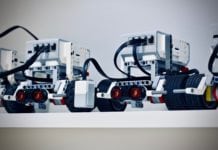
Amazon. We need to talk.
It was revealed that Amazon was granted two patents to make a wrist device that would track warehouse workers and send them performance guidance and feedback through haptic signals (such as giving them directions to a shelf location).
At first, this patent was misinterpreted as a device that was going to be used in the field, such as for delivery drivers. This connection wasn’t completely out of left field, as Amazon is known for having ambitious targets that can sometimes overwhelm employees. While people were rightfully creeped out by this concept, some argued that it could help discourage inappropriate delivery behavior (especially as smart home technology enables delivery drivers to access to the inside of customer’s homes).
Others argued that beyond being creepy, it was just simply going too far. Is this the direction that wearable technology is heading? Sure, brick and mortar retail is facing an “apocalypse” (according to industry reports), which means that online shopping is increasing. Even still, is this really necessary?
Regrouping to consider how the technology is actually planning on being used – in warehouses instead of out in the field – I still think this type of thing is better off being used on robots, not people. Amazon plans to use these devices in their fulfilment warehouses (at least for now), as a way to track workers’ hands as a way to help them navigate the large spaces and the endless shelves.
OK so here’s the plan, as we know it today; Amazon wants to use these wrist devices to:
- Improve the efficiency of warehouses
- Allow human workers to fulfil more orders
- Advance the process that is used to fulfil orders
- Free workers’ hands from having to hold scanners
- Allow workers’ autonomous guidance that helps keeps their eyes off a computer screen
- Keep track of products as they move around the warehouse
And not to, say, I don’t know, track their workers’ every move like some ego-hungry Big Brother. Or slowly turn humans into robots. Or create that crazy factory, Autofac, from Philip K. Dick’s Electric Dreams (streaming on Netflix and worth a watch, it’s from season 1, episode 8).
If this is the warehouse of the present, what will the warehouse of the future look like? This patent feels like a last ditch effort to make humans more efficient before everything is just turned over to the robots anyway. I suppose if this technology is going to be used anywhere, warehouses make the most sense. I just hope that the work/life balance doesn’t tilt in the wrong direction with employers thinking they can use technology to track their workers’ every move – in and out of the office.
Do you support this technology being used this way? There is still a lot to learn about Amazon’s intentions, but I personally feel like maybe we can all just wait an extra few hours to get our products, instead of taking the first step into what could be a deep, dark rabbit hole. Who knows maybe my conspiracy theorist friends were right…




